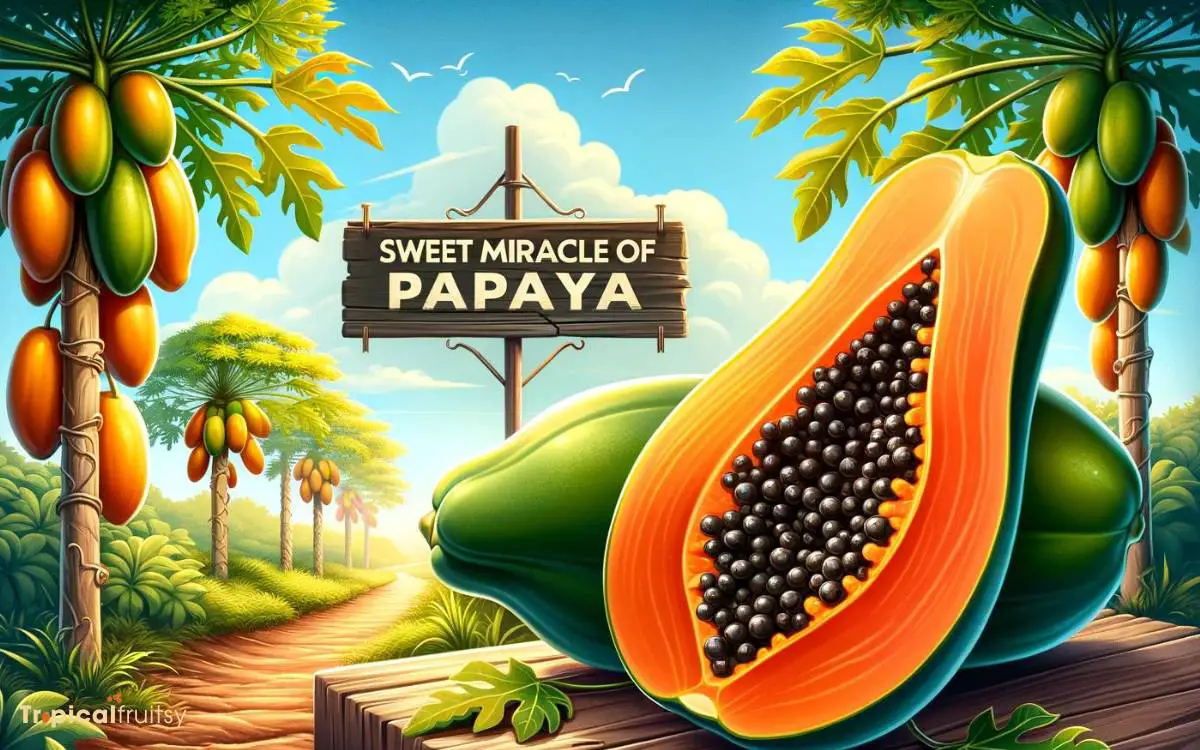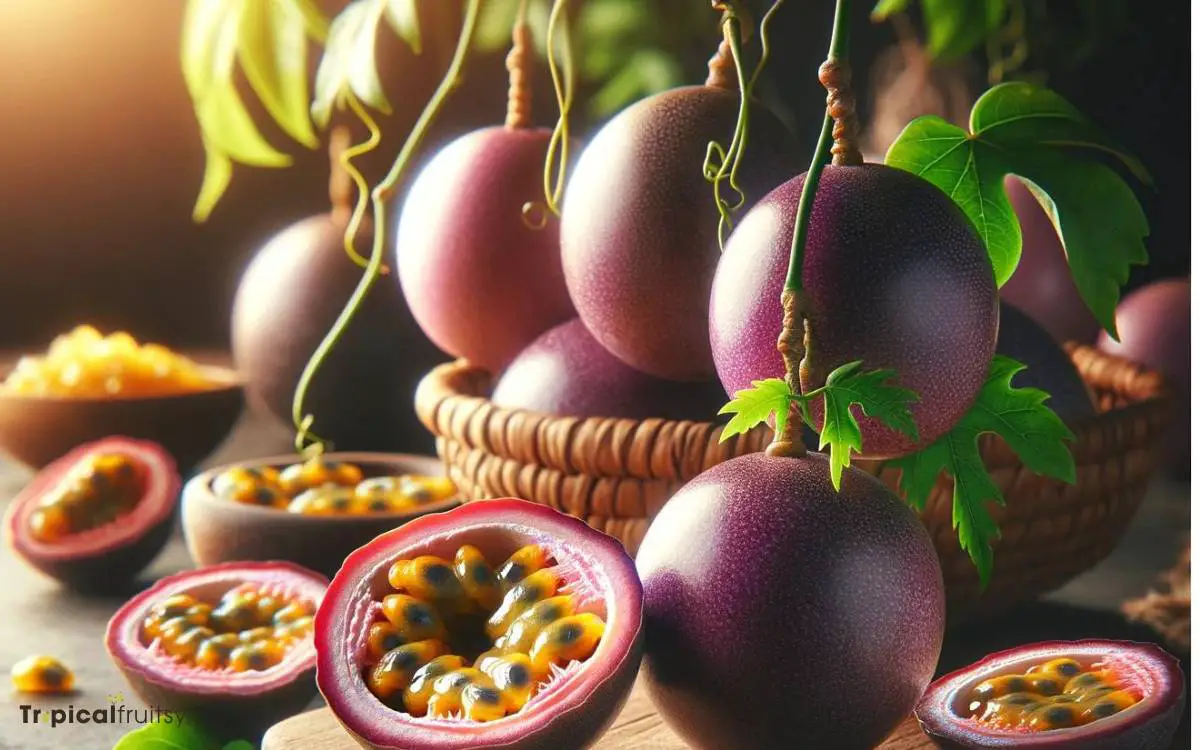List of Yellow Tropical Fruits: Explore!
Yellow tropical fruits are a treasure trove of flavors and health benefits. The list includes popular fruits like bananas, pineapples, mangoes, as well as exotic options like starfruit, papaya, soursop, canistel, and passion fruit.
These fruits are not only delicious but also packed with vitamins, minerals, and antioxidants that are essential for good health.
Yellow tropical fruits are characterized by their vibrant color, which is usually a sign of full ripeness.
These fruits typically have a sweet and sometimes tangy taste profile, and they offer a variety of textures from creamy to juicy. They are rich in nutrients like Vitamin C, potassium, and dietary fiber.
Here’s a brief overview:
Explore the symphony of flavors and health perks with every bite of these succulent yellow tropical fruits.

Key Takeaway
8 Fruit Names: Description and Nutritional Benefits of Yellow Tropical Fruits
| Fruit Name | Description | Nutritional Benefits |
|---|---|---|
| Banana | Creamy texture, convenient snack | High in potassium, Vitamin B6, and fiber |
| Pineapple | Sweet and tart, refreshing | Rich in Vitamin C and manganese |
| Mango | Succulent, varying sweetness depending on the variety | Excellent source of Vitamin A and C |
| Starfruit | Crisp texture, unique star shape when sliced | Contains fiber, Vitamin C, and antioxidants |
| Papaya | Sweet with a buttery texture | High in Vitamin C, Vitamin A, and folate |
| Soursop | Combination of strawberry and apple with citrus notes | Antioxidant properties, Vitamin C, and fiber |
| Canistel | Custard-like texture, also known as eggfruit | Vitamin A, Vitamin C, and calcium |
| Passion Fruit | Tart flavor, fragrant aroma, edible seeds | Rich in antioxidants, Vitamin C, and fiber |
The Versatile Banana

While widely recognized for its sweet taste and soft texture, the banana is a versatile yellow tropical fruit with a myriad of culinary and nutritional applications.
Originating from Southeast Asia, this elongated, crescent-shaped fruit is an indispensable staple in many diets around the globe.
Packed with essential vitamins and minerals such as vitamin C, potassium, and dietary fiber, bananas play a crucial role in maintaining heart health and regular digestive function.
Their natural sugars—glucose, fructose, and sucrose—offer a quick energy boost, making them a favorite among athletes.
In the kitchen, bananas can be transformed into an array of dishes, from smoothies and desserts to savory meals, and their leaves are often used as eco-friendly, biodegradable plates or food wrappers.
Sun-Kissed Pineapple

The pineapple, with its distinctive spiky crown and vibrant yellow flesh, is not only a symbol of tropical abundance but also a powerhouse of nutrients, including vitamin C, manganese, and dietary fiber.
Its culinary flexibility shines in a variety of dishes, from the sweet tang of a Hawaiian pizza to the exotic flavors of Southeast Asian cuisine.
Understanding the cultivation process of this fruit, which thrives in warm climates and requires careful tending, is essential for appreciating the journey from plantation to plate.
Pineapple Nutritional Benefits
Pineapple’s rich vitamin C content makes it an excellent choice for supporting immune system health and providing antioxidant benefits. This tropical fruit is not only a delightful treat but also a powerhouse of nutrients.
Its benefits extend to various aspects of wellness:
Digestive Health:
- Bromelain: An enzyme that aids digestion and reduces inflammation.
- Fiber: Promotes regular bowel movements and digestive tract health.
Anti-Inflammatory Properties:
- Vitamin C: Helps in reducing inflammation.
- Manganese: Essential for bone health and an important cofactor in reducing inflammation.
Energy Production and Cell Protection:
- Thiamin: A B vitamin involved in energy production.
- Antioxidants: Protect cells from oxidative stress and support overall health.
Consuming pineapple may thus contribute significantly to a balanced diet and robust health.
Culinary Uses
Beyond its nutritional prowess, pineapple features prominently in culinary applications, ranging from sweet desserts to savory dishes. Its vibrant acidity and exotic sweetness make it a versatile ingredient that enhances flavor profiles.
In desserts, pineapple is often the star component in cakes, such as the classic upside-down cake, and in refreshing sorbets.
It is also a popular addition to fruit salads, where its tartness can balance the sweetness of other fruits.
Savory applications include its incorporation into salsas, which accompany grilled meats and seafood, offering a delightful contrast. Moreover, pineapple’s tenderizing enzymes make it an excellent marinade for proteins.
It is also a traditional ingredient in Asian stir-fries and Caribbean cuisine, where it contributes a tropical flair to various dishes.
Growing Pineapples
Cultivating pineapples in tropical climates typically requires a warm environment with well-drained soil to ensure optimal growth and fruit development.
These perennial plants thrive in temperatures between 65°F and 95°F and can often be propagated from the crowns of the fruit itself.
Essential Conditions for Pineapple Cultivation:
- Temperature: 65°F to 95°F for proper enzyme activity.
- Soil: Slightly acidic (pH 4.5-6.5), well-drained, and rich in organic matter.
- Water: Consistent moisture is crucial, but overwatering can lead to root rot.
To avoid water stagnation, raised beds or mounds are recommended. Furthermore, pineapples require adequate spacing, about 3 to 4 feet apart, to allow for their sprawling growth habit and to enable sufficient sunlight penetration for each plant.
Exotic Mango Varieties

Several exotic mango varieties, characterized by their vibrant yellow hues and unique flavor profiles, enrich the diversity of tropical fruits available on the global market.
These varieties, often hailed from different corners of the world, offer a distinct taste and textural experience that is highly sought after by culinary enthusiasts and fruit connoisseurs alike.
| Variety | Origin |
|---|---|
| Alphonso | India |
| Ataulfo | Mexico |
| Kent | Ecuador |
The Alphonso mango, also known as the ‘King of Mangoes’, is renowned for its rich, creamy flavor and intense aroma. Originating from India, this variety has a deep yellow flesh and is often used in desserts and smoothies.
The Ataulfo mango from Mexico, also known as the ‘Honey’ or ‘Champagne’ mango, has a sweet, buttery taste with a smooth, fiberless flesh.
Lastly, the Kent mango from Ecuador presents a juicy, tender texture with a sweet and rich flavor, making it a favorite for fresh consumption as well as in salsas and salads.
Tangy Starfruit Wonders

Transitioning from the succulence of exotic mangoes, the starfruit emerges as another vibrant yellow tropical delicacy, offering a refreshingly tangy flavor that captivates the palates of fruit enthusiasts worldwide.
Carambola, commonly known as starfruit, is distinguished not only by its unique star shape when sliced but also by its composition and benefits:
Nutritional Value:
- High in vitamin C
- Rich in antioxidants
- Contains fiber
Culinary Versatility:
- Eaten raw or cooked
- Used in salads, drinks, and desserts
- Complements savory dishes
Cultivation and Varieties:
- Grows in warm, tropical climates
- Multiple varieties with varying sweetness
- Widely available in Southeast Asia, South America, and the Pacific Islands
Starfruit’s distinct, tangy taste and potential health benefits make it a noteworthy addition to the spectrum of yellow tropical fruits.
Sweet Miracle of Papaya

The papaya, with its vibrant yellow flesh, offers a myriad of health benefits, including a rich source of vitamins A, C, and E, and digestive enzymes like papain.
Understanding its cultivation techniques is essential, as the fruit thrives in tropical climates with careful attention to soil quality and frost protection.
From savory dishes to sweet desserts, the culinary uses of papaya are diverse, allowing chefs and home cooks to explore its versatility in the kitchen.
Health Benefits
Boasting a rich content of vitamins A and C, the papaya, a vibrant yellow tropical fruit, offers numerous health benefits that enhance overall wellness.
This succulent fruit is more than just a tasty treat; it’s a treasure trove of nutritional value that can contribute to a healthier life.
Digestive Health:
- Enzyme Papain: Aids in breaking down proteins and facilitates healthy digestion.
- Fiber Content: Helps to regulate bowel movements.
- Anti-inflammatory Properties: Reduces gut inflammation.
Papaya’s antioxidants, like lycopene, defend against cellular damage, potentially lowering the risk of chronic diseases. Moreover, the folate and potassium present support cardiovascular health.
For those seeking a natural immune boost, the high vitamin C content in papaya is an excellent ally. Thus, this tropical delight is a holistic food that supports multiple aspects of physical health.
Cultivation Techniques
Frequently, enthusiasts of the nutrient-rich papaya seek to cultivate this tropical fruit themselves, employing specific techniques to ensure a bounteous and healthy harvest.
Cultivation of papayas requires understanding of the plant’s preferences for climate, soil, and care.
| Factor | Description | Consideration |
|---|---|---|
| Climate | Papayas thrive in warm, tropical climates. | Avoid areas with frost. |
| Soil | Well-drained, fertile, and rich in organic matter. | Maintain pH between 6.0 and 6.5. |
| Planting | Papayas need ample space for root growth. | Plant seeds or seedlings 8-10 feet apart. |
| Watering | Regular, consistent irrigation is crucial. | Avoid waterlogging to prevent root rot. |
Adhering to these guidelines will significantly enhance the chances of cultivating a successful papaya crop, yielding the sweet, succulent fruits that are both delicious and nutritious.
Culinary Uses
Incorporating papaya into culinary creations offers a versatile range of sweet and savory applications, from fresh fruit salads to spiced chutneys.
The vibrant flesh of papaya lends itself to a multitude of dishes:
Breakfast Options:
- Topped with yogurt and granola for a tropical parfait
- Blended into smoothies for a nutritious morning beverage
- Sliced and served alongside pancakes or waffles
Papaya’s natural sweetness enhances desserts and baked goods, while its tenderizing enzymes make it ideal for meat marinades.
This multifaceted fruit can also be the star ingredient in exotic salsas, offering a sweet counterpart to spicy elements.
As culinary enthusiasts explore the sweet miracle of papaya, they can anticipate the transition to another tropical wonder with the unique flavors of soursop.
Unique Flavors of Soursop

Among the pantheon of tropical fruits, soursop stands out for its complex flavor profile, often described as a combination of strawberry, pineapple, and citrus with a creamy texture reminiscent of coconut or banana.
This distinct taste has made soursop a favorite among culinary enthusiasts and has secured its place in a variety of dishes, from refreshing beverages to rich desserts.
The pulp’s unique flavor is not only enjoyed fresh but also harnessed in jellies, syrups, and ice creams.
Nutritionally, soursop is notable for its vitamin C, B vitamins, and antioxidants, which contribute to its health-promoting qualities.
The allure of soursop’s flavor extends beyond its taste to its potential therapeutic benefits, making it a fruit of great interest.
Transitioning from the intriguing flavors of soursop, let us now explore the tropical canistel delights.
Tropical Canistel Delights

How does the canistel, with its vibrant yellow flesh, compare to the intricate flavors of soursop in the realm of tropical fruits?
Known as Egg Fruit for its custard-like texture, canistel is less known but equally deserving of attention for its unique taste and versatility.
Originating from Central America, this fruit is not just a treat to the palate but also a powerhouse of nutrition, including:
Vitamins:
- High in Vitamin A and carotenes.
- Beta-carotene
- Lutein
Minerals:
- Provides calcium and phosphorus.
- Essential for bone health
Antioxidants:
- Contains antioxidants that help protect the body.
- Fights free radicals
Professionals within the culinary and nutrition fields praise canistel for its dietary benefits and adaptability in recipes.
As we delve into the subtleties of this lesser-known fruit, let us transition to the zesty and refreshing passion fruit, another gem of the tropics.
Are Yellow Tropical Fruits Common in Tropical Rainforests?
Yes, yellow tropical fruits in tropical rainforests are quite common. These fruits in tropical rainforest include bananas, pineapples, and mangoes, which thrive in the warm and humid conditions of the rainforest. Their vibrant colors and sweet flavors are a hallmark of the lush tropical environment.
Refreshing Passion Fruit

Several passion fruit varieties, recognized for their aromatic fragrance and tangy taste, provide a wealth of nutrients, including significant amounts of vitamin C and dietary fiber.
Originating from South America, these small, round fruits with a tough outer rind encase a cluster of seeds surrounded by juicy, flavorful pulp.
The yellow variety, specifically, is known for its slightly sweeter flavor profile compared to its purple counterpart and is a popular choice for fresh consumption, juices, and desserts.
Passion fruit is not only lauded for its culinary versatility but also for its health benefits. It contains antioxidants that are integral for warding off free radicals and compounds that contribute to heart health and reduced inflammation.
Incorporating passion fruit into a balanced diet can support overall wellness while offering a delightful tropical experience.
Conclusion
The plethora of yellow tropical fruits offers a veritable cornucopia of flavors, textures, and nutritional benefits.
From the ubiquitous banana to the unique canistel, each fruit presents a symphony of taste that tantalizes the palate.
These golden treasures of the tropics not only enrich culinary experiences but also contribute significantly to a balanced diet.
As an allegory to the diverse spectrum of nature’s bounty, they underscore the richness that biodiversity brings to our tables.






